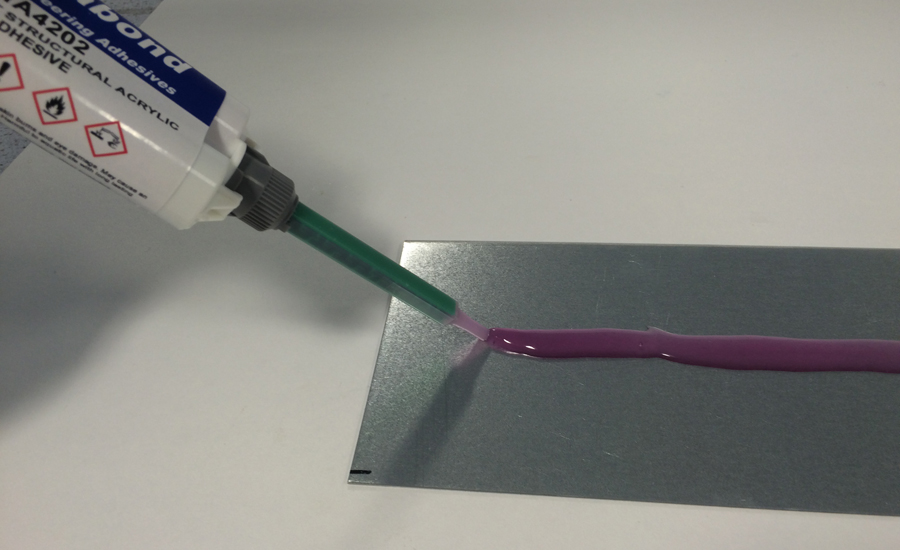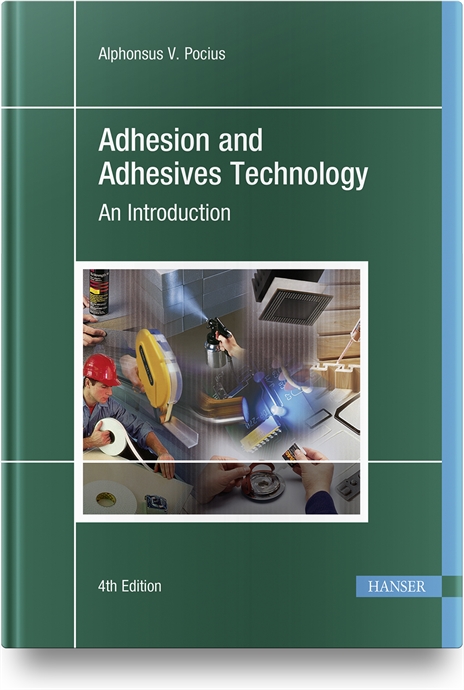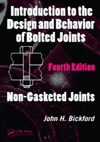Meter, Mix and Dispense Two-Part Adhesives

Metering, mixing and dispensing multicomponent adhesives offers unique challenges and opportunities for assemblers. Various manual and automated methods are available.
The good things of life are not to be had singly, but come to us with a mixture." That statement, written in the early 19th century by Charles Lamb, a British essayist and poet, could easily apply to today's manufacturing environment.
More and more assemblers are turning to two-component adhesives for improved quality, productivity and efficiency. Acrylics, epoxies, silicones, urethanes and other adhesives have a number of performance properties often not available in single-component materials.
For instance, two-part adhesives offer faster handling and cure times, and a variety of formulations to meet a growing number of applications. The rate of cure and cure characteristics are primarily controlled by the chemistry, whereas single-component adhesives rely on some part of the environment to cure.
Typically, the material cost of a dual component is higher, but the benefits in rate of cure, bond strength and application flexibility outweigh the cost difference. In many cases, two-part adhesives offer longer shelf life, without adverse effects on performance qualities.
Two-part formulations typically can achieve properties that the single-component material cannot. Properties such as shrinkage, room-temperature cure, heat transfer ability, electrical insulation, chemical compatibility and adhesion are either not available or are not as desirable in a one-part adhesive.
However, there are disadvantages, such as the cost of equipment needed to process two-part materials. Indeed, automatic metering and mixing machines can cost $8,000 to $10,000 apiece, with robotic systems pushing the price tag to $50,000 and up. But, if the application is large enough, the cost of the equipment can easily be offset by the reduction in labor and the improvement in quality.
Meter-mix systems are available from some manufacturers that can run as low as $3,000 to $4,000, but do not necessarily offer precise ratio control or long-term durability. For applications that do not require stringent quality control, these systems may prove to be totally adequate.
Often, however, these systems will not satisfy the rigid standards set by manufacturers whose products demand consistently high levels of quality. The difference in cost can be as little as $600 or as much as $30,000 to $40,000, depending on the level of sophistication and automated features.
Growing Demand
According to The Freedonia Group Inc., two-part reactive adhesives, such as epoxies and acrylics, are gaining ground in the automotive industry, largely at the expense of solvent-borne systems. As more composite materials, such as door panels and interior trim, are used to increase fuel economy and crash safety, adhesives are gaining more acceptance. Dual-component adhesives are usually less expensive and perform comparable to or better than mechanical fasteners or welding.
The electronics industry uses a wide variety of multicomponent adhesives as well. For instance, most potting and encapsulating applications for vibration protection, environmental protection or electrical isolation use two-part material. Flip chip bonding and fiber optics are also on the cutting edge of multicomponent adhesive technology.
Medical device manufacturers use multipart adhesives to assemble monitoring devices, patient support surfaces, patient implants and other products where clean, reliable bonding is required. Other heavy users of two-part material include cable manufacturers, filtration assemblers and yacht builders.
Freedonia researchers predict continued demand for multicomponent adhesives. In fact, epoxies, urethanes and other two-part formulations are expected to grow 3.9 percent a year during the rest of this decade.
As more manufacturers use multicomponent adhesives, demand for metering and mixing equipment has increased. In any competitive situation, gaining control over quality and costs is paramount. Even in an economic downturn, manufacturers need to optimize all aspects of production in order to contain costs.

Manual vs. Machine
Assemblers face unique challenges when blending and dispensing multicomponent adhesives. Correctly measuring the amount of A and B material so you have the right ratio is very important. Too much or too little can result in numerous headaches, such as inconsistent performance, poor quality and excessive cost. Fortunately, a wide variety of manual and automated systems is available.
Multicomponent adhesives can be mixed by hand, with a process similar to making cookie dough. Hand mixing requires weighing specific amounts of catalyst and base. After the two are measured, the mixing must be consistent to ensure correct curing. And, dispensing from a hand-mixed vessel can be awkward and wasteful.
A lot of people mix adhesives by hand. The market is still full of small cans and jars of adhesive. For manufacturers that are trying to prototype a new product or initiate limited production runs, hand mixing is often utilized and can be somewhat cost effective. However, hand mixing results in wasted material, operator exposure to potentially toxic materials, poor ratio control and subsequent curing anomalies.
Hand mixing is unreliable, not repeatable and usually produces excess waste. However, for applications requiring small amounts of adhesive, this is the preferred method to the expense of a meter-mix system. Hand mixing, depending upon the application, has a labor cost and an adhesive cost.
Automated metering, mixing and dispensing systems offer an alternative to hand mixing. They provide precise ratio control, improved mixing, little or no wasted material and limited exposure to toxins.
Meter-mixing equipment allows easy, consistent mixing of material. The application staff does not have to weigh or measure. Instead, the machine ensures the correct ratio and mixers attached to the machine ensure correct mixing without the air entrapment experienced with hand mixing.
A less expensive alternative to meter-mixing equipment is dual-cartridge dispensing, which uses handheld dispensing guns. The easy-to-use plastic cartridges isolate the user from the material, the material is on ratio and mixing is achieved by a static mixer.
This process is as easy as dispensing a tube of household caulk. Cartridges eliminate the need for expensive meter-mix equipment while maintaining the principles of meter-mix. Because dual cartridges are very mobile, they're ideal for field applications. Capacities range from 50 to 1,500 milliliters, but most assemblers prefer 200- or 400-milliliter cartridges. Cartridges typically can't be reused and must be disposed of.
Another option often overlooked by assemblers is premixed, frozen adhesives. The mixture is brought to a homogenous blend, placed into a syringe or other form of container, and immediately brought to a temperature of -90 to -100 F. This immediately suspends any chemical reaction that is needed for material cure.
Frozen containers are packed in dry ice and shipped overnight to the end user. Thaw occurs by a warm water bath, microwave, hot air or other means that will bring the material to a workable and dispensable consistency. Premixed and frozen adhesives are typically used for small-dot applications common in the electronics industry. It eliminates the need for repeated batch mixing.
Barrier packs are another good alternative for two- and three-component materials. Barrier and injection systems are used mostly where there is a resin- or curative-type material.
Barrier cartridges have a foiled mixer dasher that is held in place inside the cartridge with a cinch tape on the outside of the cartridge. The resin and curative are separated by the foil. Injection systems consist of a cartridge filled with resin and an injection rod that contains the curative. The ramrod is pushed or jolted against a rod piston, compressing the material and causing the rod valve to rupture, injecting the curative into the resin.
Mixing Methods
Mixers can be either static or dynamic. Static mixers have no moving parts. They contain fixed, geometrically shaped elements that act as flow-splitting and shear-energy-creating devices for the materials that travel through them. Static mixers are usually either plastic or metal. They work well if the ratio and viscosity ranges of the two materials to be mixed are not too wide.
Static mixers serve as inline mixers--the components to be mixed are pumped through the mixer and emerge out the end totally mixed. They can be used with both two-component machines and cartridge applications.
Disposable static mixers are more popular than they were 5 years ago, because of the proliferation of two-component materials. Health and environmental issues, such as worker exposure to the materials themselves and the solvents needed to clean them off hands, tools and equipment, have also contributed.
While static mixers have been around since the 1960s, the technology has changed very little over the years. One of the newest developments is a disposable mixer featuring a square-element geometry based on computer simulation. The pressure drop in square mixers is said to be much lower than helical-type mixers with the same dimensions.
In dynamic mixers, materials are rotated with an auger or paddle within a mixing chamber by means of rotary air, electric or hydraulic motors. In dynamic mixing, the material passes into a chamber with a rotating element. Higher mixing and shear is created, providing better mixing.
Most dynamic mixers must be thoroughly cleaned after use, which takes time and exposes workers to hazardous waste. Typically, these mechanical mixers require solvent flush of the chamber. However, a hybrid dispense head is available that combines dynamic mixing with solvent-free mix chambers.
Metering Devices
A metering unit is essential for accurate volumetric dispensing of multicomponent adhesives. Meters help dispense precise volumes of adhesive at precise time intervals and pressures. The ratio and flow rate can be fixed or variable.
A pump is used to transfer adhesive from a point of supply, such as a 5-gallon pail, a 55-gallon drum or a 300-gallon tote, to a dispense head. A wide variety of pumping technology and equipment choices is available.
Shot-based systems include piston pumps and rod pumps. Continuous-flow systems include gear pumps and progressive cavity pumps. You have to define the accuracy needed for your application.
Gear pumps generally give the greatest accuracy, but for most applications, piston and rod systems work great and are less expensive. The advantages or disadvantages of each system usually depend on the type of adhesive being dispensed. Properties such as viscosity, specific gravity, mix ratio, sheer sensitivity and chemistry filler dictate the correct system to use.
Gear pumps are positive displacement devices that provide continuous flow with the ability to control flow rate. They work well in applications where high, continuous flow is required, such as bead dispensing utilizing X-Y motion. Precision gear pumps usually will not tolerate formulations with fillers or abrasive content, as they tend to wear the metering components quickly. Gear pumps typically cost more than other metering methods.
Piston pumps are the most universally applied method of metering. They are versatile, reliable and repeatable. Two basic types are available: single-acting and double-acting. Capital outlay tends to be less than with gear pumps. Piston pumps also can be configured to handle abrasive, filled materials. Pneumatics are often used to move the fluid, so flow rates tend to vary slightly. However, servo drives can be used instead of pneumatics if the application requires it.
Rod pumps are used primarily in applications with a high abrasive content. They rely on blind metering, so there are fewer seals to wear than traditional piston metering. But, a limited range of bore sizes is available. Rod pumps also require lots of cycles to achieve a given volume.
Progressive cavity pumps are similar to an Archimedes screw rotating within a fixed cylinder. Material fills the voids in the screw and is transported through the cylinder. As the screw speed increases, flow rate also increases. However, progressive cavity pumps require compensating devices or controls due to the constant wear of internal volumetric components.
Gear and piston pumps account for approximately 60 percent of the market, followed by rod and progressive cavity pumps.
Current Trends
As assemblers demand more control and statistical feedback from their processes, meter-mix manufacturers are responding with increased levels of sophistication in system controls. Indeed, there are more options available today than ever.
Technology has allowed meter-mix equipment to become increasingly complex. For instance, varied shot size, vacuum degassing, heated tanks, multiple drum feeding systems, X-Y-Z function and PLC compatibility are all options on today's equipment.
Recent developments include:
- Bar code scanning to preset dispense parameters, even in mixed lots. It permits mixed groups of parts to be processed on the same line, where the bar code allows the meter-mix system to automatically preset the exact shot size, flow rate and other parameters.
- Vacuum impregnation systems for high voltage components to eliminate "corona" effects (arcing of high voltage through a void).
- Closed-loop control that provides real-time monitoring of flow rate and subsequent rate control modulation to maintain consistent, stable flow.
- Better, easier-to-use operator interfaces, such as touchscreens, with different access levels for assemblers, engineers and maintenance personnel.
- Fail-safe devices, such as pressure transducers, to monitor pumps, power supply and other critical factors that can affect mixing ratios and dispensing conditions.
- Servo-controlled bead dispensing, crucial to integration of fluid dispensing with X-Y automated motion.
Much of the control technology being applied to other meter-mix systems is used to compensate for design weaknesses such as ratio drift, racking and excessive wear of wet seal components. When the design focus is on intuitive mechanical layout and tight mechanical tolerances, the results are elimination of backlash, improved repeatability, increased durability and, ultimately, less need for the lights and whistles.
Some vendors are attempting to fill the void between economical cartridge systems and expensive meter-mix machines. For instance, a point-of-application metering system is available featuring a pneumatically driven, positive displacement pump, a backpack to hold the adhesive supply and a handheld dispenser. Such devices cost between $3,000 to $5,000.
Common Mistakes
Although a wide range of adhesive blending options is available, assemblers don't always choose the best system to match their needs. With meter-mix equipment, there's no such thing as one-size-fits-all. It's an unfortunate lesson that too many people learn the hard way. You don't learn about metering, mixing and dispensing in college.
Lack of a preventive maintenance program is the biggest mistake assemblers make with metering, mixing and dispensing equipment. It's a major problem. Too many people don't pay attention to their equipment. It's important to replace wear items, check the seals and check for contamination.
Make a commitment to implement and support a good preventive maintenance policy. Poor maintenance procedures are sure to bring on premature downtime. Mixing plural component adhesives can be a messy business, and if the equipment is allowed to run down, poor attitudes will follow.
Assemblers are well-advised to design good production procedures before installing meter-mix equipment. Sloppy production procedures and failure to enforce the procedures will yield poor results. Procedures should include checking fluid levels at appropriate intervals--every day if necessary; taking mixed material samples for quality control before initiating production runs; and designating responsible personnel who will monitor and remedy problems as they occur.
Assemblers should also avoid making the following mistakes:
- Designating the "lowest guy on the totem pole" to be responsible for the system. This often leads to poor maintenance procedures and a loss of production time.
- Selecting a resin that is not necessarily the most user or process friendly. While it may satisfy the product requirements, it also may impose unnecessary problems in production.
- Allowing a meter-mix system to run out of material. This introduces air into the system, one of the most common troubleshooting issues. Air displaces fluid, causing off-ratio metering, incomplete curing of material, and air infusion and voids in the mixed product.
- Crossing two materials on the machine.
- Leaving material in the mixing chamber too long. Multicomponent adhesives typically have a short work life. Adhesive can start to cure on the perimeter of the mixer. As it builds up, it inhibits the mixing. To prevent clogs, automatic purge cycles should be programmed into dispensing equipment.
- Allowing material to sit out exposed to excess light, heat, cold or other potentially harmful environmental conditions.
When searching for a new adhesive material or supplier, be sure to consider how the meter-mix system will fit into the equation. Many manufacturers address a new production requirement by first looking at resins. Logically, they choose a resin based primarily on its ability to satisfy the production requirements, such as tensile strength, elasticity, heat dissipation qualities or flame resistance, without any thought as to how easy or difficult it may be to process in a meter-mix system.
Only after they have gone through exhaustive testing of samples and submitted them for approval do they then consider the equally important process of how to best deliver the resin into the product. Ideally, the search should simultaneously consider both criteria.
By using this approach, end users might discover that a number of resins may be suitable for the application, but the one with the less abrasive filler, such as calcium carbonate vs. aluminum oxide, will impact their preventive maintenance cycle less. Or, the product with a closer mix ratio--for instance, 2-to-1 vs. 10-to-1--will process more easily, causing fewer rejects.
Abrasive products inevitably demand higher maintenance cycles. And closer mix ratios can generally be processed more easily than wide ratios.
Looking for a reprint of this article?
From high-res PDFs to custom plaques, order your copy today!







